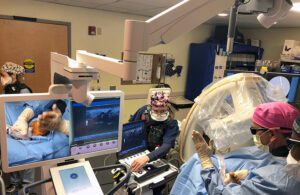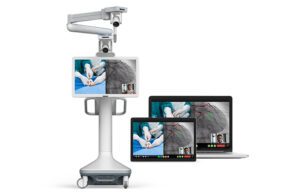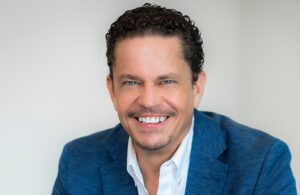
The Avail Medsystems console brings remote experts into the operating room virtually. [Photo courtesy of Avail Medsystems]
Avail executives said they hope it will be the first of many partnerships with medical technology developers of software or algorithms that could be useful in the operating room.
Avail CEO Daniel Hawkins expects to launch the software integration in the first quarter of 2023, he told Medical Design & Outsourcing after a panel discussion at DeviceTalks West in Santa Clara, California. He declined to name his company’s partner, but offered some details as the product goes through UI and customer experience testing.
“A remote user can pull up that software and optimize the workflow in a specialty category that really benefits from workflow enhancement,” he said. “The beautiful part is that same workflow enhancement capability can be put into other clinical specialties to optimize new product adoption workflows.”

The Avail Medsystems telepresence console can beam video, audio and information to laptops and tablets. [Photo courtesy of Avail Medsystems]
RELATED: How Avail Medsystems seeks to create a connected OR experience
“Workflow optimization software is only useful if the people in the room can actually see the workflow. That’s what this is, because of our flat panel in the room. … This capability is leveraging from a remote perspective an ability to display what you choose on the screen to optimize workflow in complicated procedures,” Hawkins said.
Avail designed its system with the ability to add computing power to support additional software that it plans to develop, as well as third-party offerings. That could include workflow software, Software as a Medical Device (SaMD) products without any hardware and software that partners with smart devices.
Speaking to an audience of medtech professionals including designers and engineers, Hawkins laid out the plan to use Avail’s network of devices as platforms for operating room software.

Avail Medsystems CEO Daniel Hawkins [Photo courtesy of Avail Medsystems]
Chief Technology Officer James Domine — previously of TiVo, Ericsson and Microsoft — said the system will serve as a host for the “huge explosion” of medtech software in need of a device with a presence in the operating room.
“No longer is it just the algorithms we write in traditional computer programs,” he said. “Now it’s moved on into and evolved into machine learning and AI. And your product in that world could be a model. It’s entirely virtual. … I’m really excited about this because there’s this world of opportunities where people are doing amazingly great work, but what they’re missing is a host.”




![A photo of the Medtronic GI Genius ColonPro polyp detection system flagging a potential sign of colon cancer during a colonoscopy. [Photo courtesy of Medtronic]](https://www.medicaldesignandoutsourcing.com/wp-content/uploads/2024/04/Medtronic-GI-Genius-doctors-268x170.jpg)